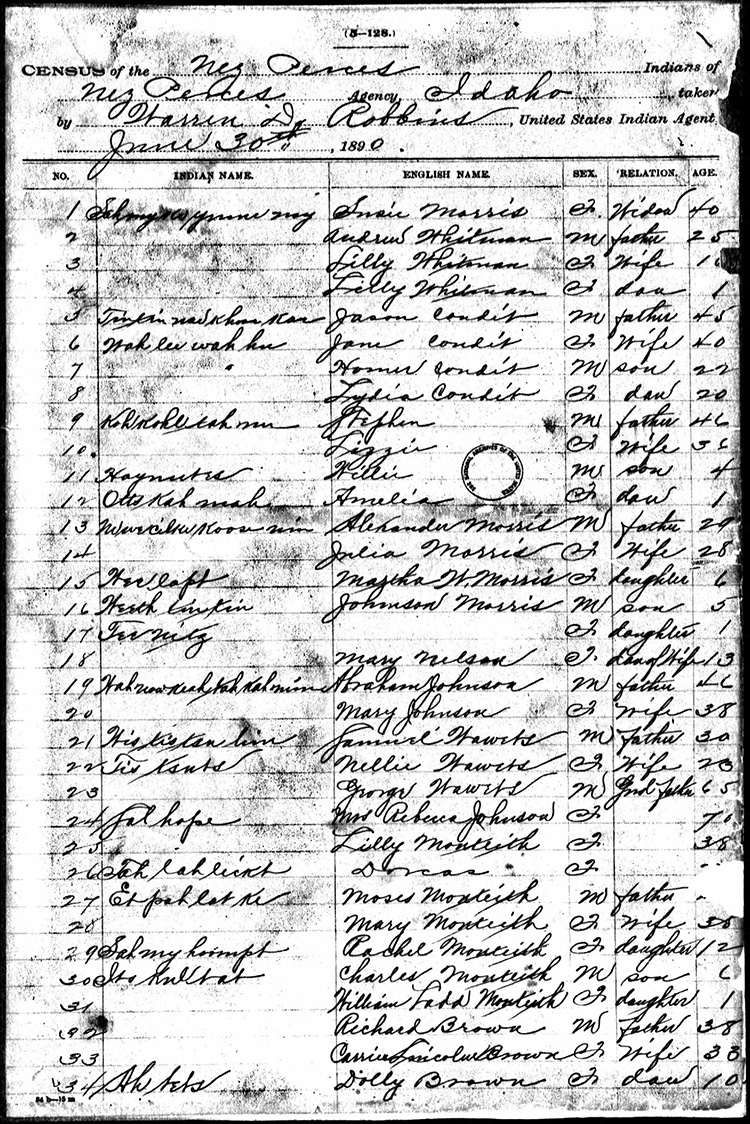

Census RecordsIndian Census Rolls, 1885–1940 |
Agents and superintendents at American Indian reservations annually submitted census rolls starting in 1885. These rolls include individuals and families who maintained a formal connection with federally recognized American Indian tribes.
The questions found on the Indian Census Rolls and the process for collecting the information were not standardized, and therefore vary between years, tribes, and agents and superintendents. Annual censuses were discontinued in 1940.
Please note: there is not a census for every reservation or every tribe for every year.
The Indian Census Rolls are digitized and available online through multiple sources. To research these records, you will need the name of the individual or family. Knowing their tribal affiliation and where they lived can also be helpful.
What Information Can the Indian Census Rolls Provide?
Because questions varied between censuses, not all Indian Census Rolls provide the same information about an individual or family. Depending on the year, the Indian Census Rolls may provide some or all of the following information about American Indians and their families:
- Name (American Indian and/or English)
- Gender
- Age
- Birth date
- Agency/Reservation name
- Marital status
- Tribe
How Can I Access the Indian Census Rolls?
The Indian Census Rolls were microfilmed as National Archives Microfilm Publication M595. M595 is digitized and available on the following websites:
-
Ancestry.com (database title: "U.S., Indian Census Rolls, 1885–1940") – subscription based; accessible for free at National Archives research facilities
-
Fold3.com (database title: "Indian Census Rolls, 1885–1940") – subscription based; accessible for free at National Archives research facilities
-
FamilySearch.org (database title: "United States, Native American, Census Rolls, 1885–1940") – accessible for free with account creation; no account is needed at National Archives research facilities
-
Internet Archive (database title: "Indian Census of the United States – 1885–1940") – accessible for free; no account is needed
The Indian Census Rolls are searchable by name and keyword (e.g., tribe) on Ancestry, Fold3, and FamilySearch. The records can be browsed by microfilm roll on the Internet Archive.
Why Can't I Find My Ancestor in the Indian Census Rolls?
If you cannot find your ancestor in the Indian Census Rolls, consider these possibilities:
- The individual's name may be spelled differently in the records. Try searching for variant spellings.
- There may be transcription errors with the indexing. Try browsing records by the location where the individual or family lived.
- The agents or superintendents at the agency may have inadvertently left the individual or family off of the Census Rolls.
- The individual or family may not have maintained formal affiliation with a tribe under federal supervision.
-
The individual or family may not have been identified as American Indian in any federal government records.
Consider searching for your ancestor in federal population census records or Bureau of Indian Affairs records.
Are Census Rolls Available Before 1885?
Depending on the tribe you are researching, earlier census rolls might be available. The Eastern Cherokee Census Rolls, 1835–1884, are one example.
However, prior to 1885, the federal government did not create or maintain annual census rolls for tribes. Rather, census rolls were compiled for tribes under federal supervision at different times for different administrative reasons. A common reason was to determine eligibility for payments due under treaty provisions.
In general, earlier rolls contain less data than the Indian Census Rolls. In many early cases, federal officials only listed a person's name and perhaps the amount of money they received. The "roll numbers" on these documents seldom relate to earlier or later records.
To identify earlier census rolls, try searching the National Archives Catalog by tribe and keyword (e.g., "census," "rolls") and then limiting your results by decade. For more search strategies, see Tips for Successful Searches.
Congressional Serial Set
Information about American Indians before 1885 can sometimes be found in the Congressional Serial Set.
The Serial Set contains records received by Congress, primarily from agencies of the Executive Branch, and reports published by Congressional committees. Documents relating to American Indians often address claims against the government for depredations or treaty rights; some include lists of American Indians, although the lists seldom provide any detailed information about the individuals.
The Serial Set is digitized and accessible for free at National Archives research facilities; see Online Databases for a link. When searching the Serial Set, try using the individual's name and tribe as keywords.
PDF files require the free Adobe Reader.
More information on Adobe Acrobat PDF files is available on our Accessibility page.

